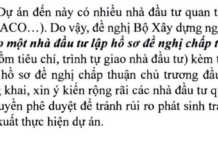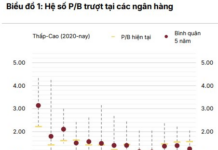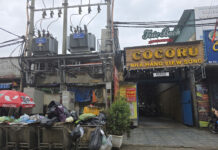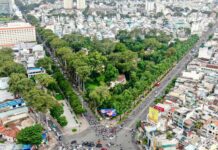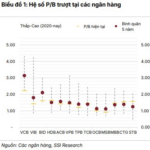Disparities in Land Prices: A Necessary Adjustment
As per the new Land Law 2024, effective from August 1st, local authorities are permitted to apply the old land price framework until December 31st, 2025, and implement a new pricing model from December 1st, 2026. This new framework will not be constrained by the land price bracket and must be formulated to align with market prices.
Ho Chi Minh City is the first locality to propose a draft of the adjusted land price framework, and the prices in this draft are significantly higher than the previous ones. For instance, in Thu Duc City, prices have increased by 10-15 times the original, while in Nha Be, Binh Chanh, Can Gio, and Cu Chi, prices have soared by 10-20 times. Notably, certain roads in Hoc Mon are expected to witness a hike of 15-30 times the original land price.

Ho Chi Minh City takes the lead in proposing a draft of the adjusted land price framework.
According to Savills Vietnam, Ho Chi Minh City’s land price framework has long been stagnant and significantly lower than the actual market value. Ms. Do Thi Thu Giang, Director of Savills Ho Chi Minh City’s Consulting Services, stated that this prolonged price disparity has resulted in a “dual-price” system, leading to several critical consequences.
Firstly, this issue complicates land management for the government. For instance, the difference between the declared price on notarized contracts and the actual transaction price, often used to reduce land transfer taxes, creates complexities. Moreover, annual land rental payments based on land prices lower than market values have led to state budget losses. ” states Ms. Giang.
The expert further elaborated on the challenges faced in real estate development, especially during the land retrieval and clearance phase. Compensation based on land prices that do not reflect market values has resulted in delays, dissatisfaction, and financial losses for affected individuals, leading to prolonged land-related disputes and litigations.
Addressing these lingering issues, Ms. Giang asserted that adopting a market-based land price framework is inevitable and necessary.
“This progressive change will overcome previous limitations, ensuring transparency and fairness in the system. Moreover, aligning land prices with market values will facilitate compensation and clearance processes, especially for vital infrastructure projects, by fostering consensus from the people regarding support and compensation levels,” she added.
However, there remains a significant gap between the proposed land prices and actual transaction prices. For instance, on Cao Thang Street in District 3, the market transaction price is approximately VND 525 million/sq.m, while the proposed price is only VND 330 million/sq.m. On Tan Thang Street in Tan Phu District, the transaction price is around VND 150 million/sq.m., but the proposed price is VND 90 million/sq.m. Overall, the proposed land prices reach only about 60% and 70% of market values in certain areas, indicating a substantial disparity.
Who Will Be Affected?
Ms. Do Thi Thu Giang pointed out that, according to Article 159 of the Land Law 2024, the land price framework is used in 11 cases. Additionally, Articles 109 and 111 of the Land Law 2024 stipulate the use of land prices according to the framework for support and resettlement arrangements. As a result, the proposed land price framework in Ho Chi Minh City will directly impact two distinct groups, benefiting one and adversely affecting the other.

Ho Chi Minh City’s proposed land price framework, which was scheduled to take effect on August 1st, has been postponed for further consideration.
The first group to benefit from this change includes individuals who receive state support in the form of land retrieval and resettlement arrangements, as outlined in Articles 109 and 111 of the Land Law 2024.
On the other hand, the affected group comprises households and individuals recognized for land use purpose conversion. Under the previous Land Law 2014, financial obligations were estimated differently for land within and beyond the limit, with land within the limit calculated based on the land price framework and land beyond the limit based on specific land prices.
However, the current Land Law 2024 does not make this distinction, and the entire area will be subject to prices according to the land price framework. Consequently, with the proposed land prices being significantly higher than the current ones, financial obligations for land within the limit will increase.
A Need for Re-evaluation
The proposed land price framework in Ho Chi Minh City, which was initially set to take effect on August 1st, has been postponed to allow for further consideration. Ms. Giang believes that this delay is reasonable, given the substantial increase in the proposed prices compared to the previous framework and the short time frame for implementation. This sudden change would have imposed significant financial pressure on the affected groups.

Constructing the land price framework requires balancing the interests of all stakeholders.
Therefore, the development and application of the land price framework must carefully consider balancing the interests of all parties involved, with a particular focus on protecting the rights of the people. The methods used to determine land prices are not yet synchronized and remain simplistic. In certain high-value areas, the approach to constructing the land price framework seems to rely solely on a fixed multiplier for all roads.
For instance, in District 1, a multiplier of 5 is applied uniformly to all locations and roads. As a result, Dong Khoi Street is proposed with a price of VND 810 million/sq.m (compared to the current VND 162 million/sq.m), and Hai Ba Trung Street (from Ben Bach Dang to Nguyen Thi Minh Khai) is set at VND 484 million/sq.m (compared to the current VND 96.8 million/sq.m). Similarly, District 4 has a multiplier of 11.3, and District 5 is at 5.58.
“This approach is essentially no different from applying the old price framework and multiplying it by a ‘K-factor,’ and thus, it does not truly reflect the market value of each road, as intended by the Land Law,” Ms. Giang remarked.
In conclusion, while updating the land price framework to align with market values is a significant step forward, Ms. Do Thi Thu Giang believes that the current proposal requires further refinement. The methodology should be adjusted to be more specific to each area, rather than relying solely on general multipliers. A gradual, transparent transition that safeguards the interests of all stakeholders is essential for long-term success.
Ensuring Effective Implementation of the Land Law 2024
According to Deputy Minister of Natural Resources and Environment, Le Minh Ngan, the workload for preparing the necessary content to ensure the effective enforcement of the Land Law 2024 from January 1, 2025 is significant, as it requires the completion of 9 Decrees, 6 Circulars, 1 Prime Minister’s Decision, and 18 detailed local provisions.
Comprehensive regional connectivity
In addition to building strong physical infrastructure, Ho Chi Minh City needs to strengthen its soft connections with other provinces in the region in order to promote economic development. This includes prioritizing the training of skilled workforce and ensuring access to quality healthcare.













